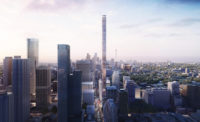Rapid population growth and a stable economy are fueling a construction boom in this Canadian metropolis.
An aerial view of East Bayfront, one of several districts being redeveloped in Toronto. |
Click on the slide show tab to view images of a scheme by Michael Van Valkenburgh Associates for the Lower Don Lands.
In most North American cities, active construction cranes are a rare sight these days. But in downtown Toronto, they’re ubiquitous, lifting up steel beams and glass panels for new towers in Canada’s largest metropolis, where the population—currently at 2.5 million—is gaining 80,000 to 100,000 people per year.
While the U.S. construction market remains in the doldrums, Toronto’s real-estate sector has been humming along since the late 1990s, with only a brief slowdown in 2008. Today, the research service Emporis is tracking 147 high-rise buildings, among other projects, under construction in Toronto; the majority are residential and office buildings in the urban core, although towers are also popping up in the suburbs. In terms of design, most of these buildings won’t turn heads. But some developers are tapping top talent in hopes of creating architectural standouts.
“We’re very excited about what’s coming,” says Alfredo Romano, head of Castlepoint Realty, one of the developers of 3C Lakeshore, a 2.4 million-square-foot district that Foster + Partners is master-planning for a former docklands. Romano says the 13-acre, mixed-use site will feature “signature towers” by Foster, along with buildings by the local firms Kuwabara Payne McKenna Blumberg and architectsAlliance.
The project is part of a larger initiative, dubbed Waterfront Toronto, to reimagine roughly 2,000 acres on Lake Ontario. West 8 has designed a series of promenades, while Michael van Valkenburgh has proposed an 18-acre park to anchor a new neighborhood. Buildings by Moshe Safdie, Pelli Clarke Pelli, and Saucier + Perrotte are now in the works. Ultimately, the Waterfront Toronto project will accommodate 40,000 residents.
Why are developers in Toronto so bullish? Romano cites the city’s consistent population growth, for starters. “Then, on a macro level, the economy is stable and secure,” he adds. “We have a strong banking sector, and our development model is a lot more conservative than in other places.” Local banks typically require new buildings to be 60 percent sold before construction begins, and mortgage lending is tighter here than in the United States. For projects with rental housing, many of the landlords are recent immigrants, from China or South Asia, who see real estate as a solid, long-term investment.
The city’s development boom isn’t free of criticism. Suburban sprawl, highway gridlock, and a transit system pushed to capacity are among the gripes. “We have a city that isn’t proactively planned, and hasn’t been for years now,” says Meg Graham, principal of the firm Superkül Architect and a professor at the University of Toronto’s architecture school.
Given the sharp market downturns in other major cities, there also are fears in Toronto of a real-estate bubble and bust, and most experts agree that a market correction is inevitable. Still, the downtown area appears relatively stable. Through the 1970s, Toronto resisted urban-renewal projects, and its prewar neighborhoods remained vital. (Jane Jacobs, who lived in the Annex neighborhood from 1968 until her death in 2006, was a major figure here.)
Good public schools, ample social services, recreational facilities, and a diverse population—over 50 percent of Torontonians are now foreign-born—make the city attractive to young people. Indeed, many of the new towers are catering to single professionals and young families who want urban lifestyles and are willing to live
in small spaces. A 500-square-foot condo in the downtown area costs at least $300,000.
Moreover, the downtown is attracting a fair share of wealthy residents. For a site along a busy road in the exclusive Yorkville district, the local firm Hariri Pontarini Architects is designing a six-story luxury condominium with limestone and glass cladding. Its 10 units (starting at 1,800 square feet) are priced from $2 million to $5 million; half have sold. “People have developed an appetite for apartment living. I think the city is anticipating a dramatic shift toward a more sophisticated, European environment,” says architect Siamak Hariri, who was born in Germany and studied at Yale.
Locally, everyone is talking about Toronto gaining world-class status; certainly, it is rivaling Montreal for the title of Canada’s cultural capital. For Hariri, Toronto offers a higher quality of life than any global metropolis. “Look at our restaurants, our live music, our galleries. People are dressing well,” he says. “It’s not a great jump to make this a better city.”
In October, the USGBC hosted its annual Greenbuild convention in Toronto. For special coverage, visit greensourcemag.com.















Post a comment to this article
Report Abusive Comment